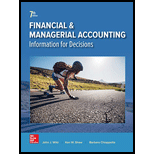
(a)
To identify:
Company which is most profitable according to its return on assets.
Return on Total Assets Ratio:
Measurement of a company’s earnings against its net assets is known as return on total assets ratio.
Debt and Equity Ratio:
Debt equity ratio is incorporated with debt and equity or shareholder’s equity used in the company. This financial ratio represents share of ‘debt’ which includes short term debt as well as long term debt and ‘equity’.
(b)
To identify:
Most risky company according to the debt ratio.
Explanation:
- Debt ratio of S, A and G Company is 26.1%, 58.9% and 18.4% respectively.
- Higher the ratio more risky will be the company.
- Here A Company has the highest ratio which shows high risk.
Thus, A Company is the most risky company according to debt ratio.
(c)
To identify:
Company deserves increased investment based on a joint analysis of return on assets and debt ratio.
Explanation:
- A Company is a more risky company since it has the highest debt equity ratio as compared with S Company and G Company.
- Whereas G Company has the lowest debt equity ratio as compared with A Company and S Company.
- These two ratios are entirely different on the basis of which comparison is quite incomplete.
Hence, these ratios do not tell about the investment related aspects.
(c)
To identify:
Company deserves increased investment based on a joint analysis of return on assets and debt ratio.
Want to see the full answer?
Check out a sample textbook solution
Chapter 2 Solutions
Financial and Managerial Accounting
- Can you help me solve this general accounting problem with the correct methodology?arrow_forwardCould you explain the steps for solving this financial accounting question accurately?arrow_forwardI need the correct answer to this general accounting problem using the standard accounting approach.arrow_forward
- I need assistance with this general accounting question using appropriate principles.arrow_forwardWhat is the production cost per unit under absorption costing ?arrow_forwardAlma Manufacturing's cost of goods sold is $520,000 variable and $310,000 fixed. The company's selling and administrative expenses are $380,000 variable and $420,000 fixed. If the company's sales revenue is $1,950,000, what is its net income?arrow_forward

 AccountingAccountingISBN:9781337272094Author:WARREN, Carl S., Reeve, James M., Duchac, Jonathan E.Publisher:Cengage Learning,
AccountingAccountingISBN:9781337272094Author:WARREN, Carl S., Reeve, James M., Duchac, Jonathan E.Publisher:Cengage Learning, Accounting Information SystemsAccountingISBN:9781337619202Author:Hall, James A.Publisher:Cengage Learning,
Accounting Information SystemsAccountingISBN:9781337619202Author:Hall, James A.Publisher:Cengage Learning, Horngren's Cost Accounting: A Managerial Emphasis...AccountingISBN:9780134475585Author:Srikant M. Datar, Madhav V. RajanPublisher:PEARSON
Horngren's Cost Accounting: A Managerial Emphasis...AccountingISBN:9780134475585Author:Srikant M. Datar, Madhav V. RajanPublisher:PEARSON Intermediate AccountingAccountingISBN:9781259722660Author:J. David Spiceland, Mark W. Nelson, Wayne M ThomasPublisher:McGraw-Hill Education
Intermediate AccountingAccountingISBN:9781259722660Author:J. David Spiceland, Mark W. Nelson, Wayne M ThomasPublisher:McGraw-Hill Education Financial and Managerial AccountingAccountingISBN:9781259726705Author:John J Wild, Ken W. Shaw, Barbara Chiappetta Fundamental Accounting PrinciplesPublisher:McGraw-Hill Education
Financial and Managerial AccountingAccountingISBN:9781259726705Author:John J Wild, Ken W. Shaw, Barbara Chiappetta Fundamental Accounting PrinciplesPublisher:McGraw-Hill Education





